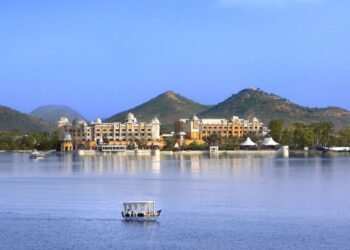Gliding through train tunnels like a serpent along some of the world’s steepest railway tracks, the candy apple-red Bernina Express is a defining feature of the Engadin Valley, a stark contrast to the Swiss valley’s smoke-gray castles and craggy peaks visible from either side of the train’s panoramic windows. This entry into the Engadin is like a tasting menu of the area’s patchwork of landscapes: steep slopes descending into V-shaped valleys, icicle-colored alpine lakes, and hillsides blanketed in wooden huts.
Located in the southern stretch of the Swiss Alps in Graubünden, the country’s largest region, the Engadin Valley’s 13 towns include one of Switzerland’s swankiest—St. Moritz, the host of the 1928 Winter Olympics. The mountain town was a popular summer locale for the Brits until the 1860s, when the Kulm Hotel transformed the area into a winter retreat with the help of the Cresta Run and Olympia Bob Run. (Considered the “birthplace of winter sports,” winter is the season that brings the most anticipated events of the year, like Snow Polo and White Turf, an international horse race on St. Moritz’s famous frozen lake.)
But the valley is taking a cue from other winter favorites like the Italian Dolomites—which offer just as much or more in the summer and fall—and touting outdoor attractions like hikes to peaks nearly 10,000 feet high and mountain biking trails traversed by professional cyclists. Hotels are also taking notice, extending their seasonal opening dates so the Engadin can be a year-round retreat. Here are some of the best things to do and places to stay when visiting the stunning, sun-drenched Swiss valley outside of ski season.
All listings featured on Condé Nast Traveler are independently selected by our editors. If you book something through our links, we may earn an affiliate commission.
Getting to and around the Engadin Valley
From Zurich Airport, the train journey is around three hours from Landquart via Klosters to the St. Moritz station. From the canton’s capital of Chur, you can cruise on the UNESCO World Heritage Rhaetian Railway (RhB) on board the Bernina Express, or make the trip from Tirano, Italy via the Bernina Pass. The panoramic Glacier Express runs from the Engadin to the Matterhorn, connecting St. Moritz/Davos and Zermatt. If you’re driving, the ride is about three hours from Zurich and Milan, or four from Munich.
The best hotels for a stay and a meal
Sleep in the spot that kick started it all, the landmark Kulm Hotel, which began as a simple guesthouse in 1864 and the first hotel in St. Moritz. Peering down at the namesake Lake St. Moritz (a popular spot in summer for windsurfing), Kulm has an air of grandeur you’d expect from a historic hotel—without being stuffy. Sure, the people-watching is better than the Cannes Film Festival (while having an aperitif in the lobby, we spotted a few celebrities casually strolling through), but you’re just as likely to see guests in après-ski attire as stilettos and fur. The majority of the 150 rooms have been renovated by French interior designer Pierre-Yves Rochon in a contemporary, alpine-chic style, swathed in pale blue and beige with ceilings of aromatherapy-approved, local Swiss stone pine.













